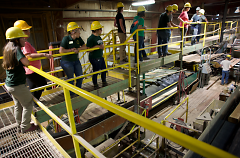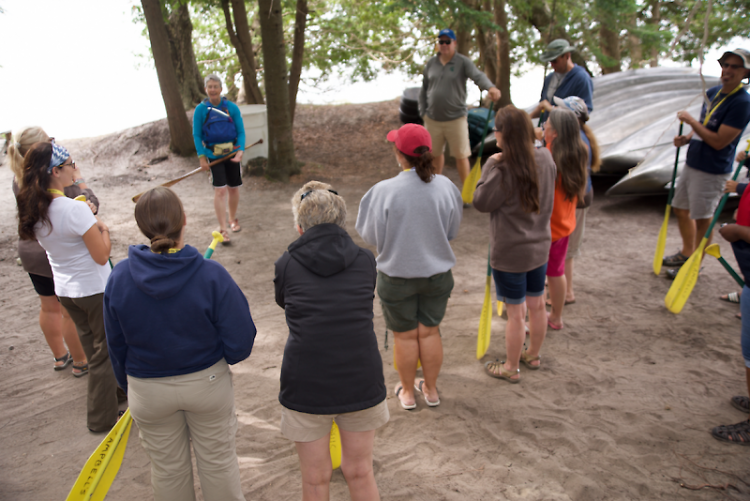Sometimes being a teacher means having to get your hands dirty — or your feet wet, as the case may be.
In July, eighth-grade environmental science teacher Leslie Montgomery picked up some practical paddling techniques from an expert canoeist on Higgins Lake as part of this year’s Academy of Natural Resources, an annual, week-long professional development course designed to enrich outdoor education in Michigan classrooms. She also learned how to build a lean-to shelter and find her way through the woods using only a compass, as well as a firsthand look at wildlife management practices.
“If you experience something, you’re more apt to be empathetic and caring about it,” Montgomery said. “I had no idea that hunting and fishing actually helped the environment. I definitely gained a shift in perspective, and consciously or unconsciously, I’m going to be passing what I learned this week along to my students.”
Montgomery teaches at Bemis Junior High School in Sterling Heights, which has easy access to a large wooded area and is located near the Clinton River. So, this school year she plans to take her students orienteering and canoeing, using techniques she gleaned from ANR.
“All children possess the potential qualities to be strong leaders, given the right experience,” Montgomery said. “With the information I learned this week, I can create a wider range of experiences for them out into the field.”
“You see two-by-fours in bundles at the store, but you never think about how they got there,” Wiers said later, standing outside the mill. “Seeing it up close like this, you realize how at every step in that process, there was a person behind it. There are so many ways to think about careers in natural resources.”
Wiers is a career guidance educator at the Careerline Tech Center, part of the Ottawa Area Intermediate School District. And for Wiers, who’s been teaching natural resource management for years, the information she picked up at ANR was right on time.
“Throughout our park systems, we’re noticing fewer people doing things like hunting and fishing, and a lot of that has to with the fact that today’s students just aren’t as connected to the outdoors as they were in the past,” she said. “This program is great because even though I’m already pretty well-versed on the subject, it does a good job at filling in some gaps, as well as touching on interesting areas such as natural resource law. There was a lot to learn.”
For Wiers’ purposes, that connection may allow her students to find a career they can be passionate about.
“The incorporation of wildlife into career-track education is relatively new, but it’s already generating some of the biggest interest at our center,” she said. “Bringing in the full breadth of natural resources topics has been great. And after taking this course, I’ve got a few more things I can incorporate to strengthen that message. I’m super excited for this school year.”
Educators interested in participating in Academy of Natural Resources can learn more at Michigan.gov/anr.
For the last 10 years, the Michigan Department of Natural Resources has utilized the ANR program to immerse Michigan teachers in wildlife- and outdoors-related activities. It’s held twice each summer at two locations: The ANR Classic takes place in early July at the Ralph A. MacMullan Conference Center on Higgins Lake, and the ANR North is set at Michigan Tech University’s Ford Center in the Western Upper Peninsula every August. The two settings get into different aspects of outdoor education, giving participants hands-on experience with a subject that’s often difficult to convey through simple words on a screen or even with videos.
“Teachers have a profound influence on society, so programs that allow them to get up close and personal with the outdoors is important if we want them to bring subjects like conservation into the classroom,” said Matt Pedigo, chair of the Michigan Wildlife Council. “Even though Michigan has an abundance of natural resources, many people still feel disconnected from our wildlife. This program is great at strengthening that connection, which will hopefully inspire the next generation to get outside and care for the environment.”
The Michigan Wildlife Council is dedicated to informing the public about the benefits of effective natural resource management. In Michigan, hunting and fishing licenses — not state taxes — fund the bulk of wildlife management practices. And like the ANR, the goal of the Michigan Wildlife Council is to forge a connection between Michigan residents and the outdoors.
“Some people mistakenly think that hunters will somehow wipe out animal populations or that cutting down trees will devastate our forests, but that couldn’t be further from the truth,” Pedigo said. “These are scientifically managed resources that need help from people because of the impact of human development to guarantee that our trees and wildlife will be here for generations to come.”
Montgomery said she’s found that some kids are better learners outside the classroom, so simply conducting her class in the woods near the school — or even on the river — can help a student who feels stifled by traditional teaching methods thrive.
“For most eighth-graders, one of the biggest problems is in self-regulation,” she said. “This kind of education is key to helping them build that skill and gives them a physical lesson that they can then apply to their actual lives. The outside element grounds and really cements that memory.”
It’s also an effective tool for introducing young people to career paths they may not have previously considered. The same day that Montgomery was getting schooled on canoeing, West Michigan instructor Avril Wiers was standing on a catwalk inside a Northern Michigan lumber mill. She and a group of about 15 others watched as the giant laser-guided buzz saw below them smoothly sliced through a maple tree trunk. In a quick series of back-and-forth cuts, the 3-feet-wide log was converted to a set of planks, which were then whisked along a conveyor to be sawn into construction lumber.
The Rapidian, a program of the 501(c)3 nonprofit Community Media Center, relies on the community’s support to help cover the cost of training reporters and publishing content.
We need your help.
If each of our readers and content creators who values this community platform help support its creation and maintenance, The Rapidian can continue to educate and facilitate a conversation around issues for years to come.
Please support The Rapidian and make a contribution today.


